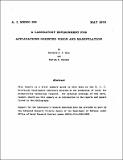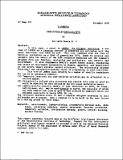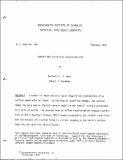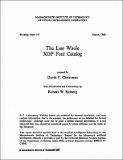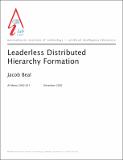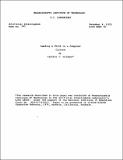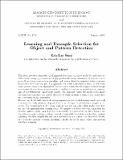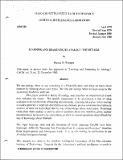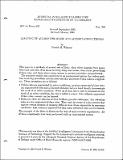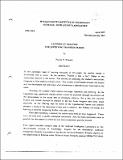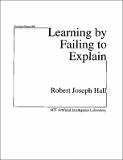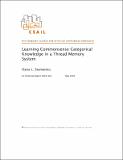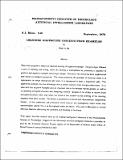Browsing Artificial Intelligence Lab Publications by Title
Now showing items 801-820 of 1835
-
The L%LINES Package
(MIT Artificial Intelligence Laboratory, 1971)The program (L%LINES X Y) takes feature point output from the FP%FPOINTS program (q.v.) for horizontal and vertical scans (X and Y respectively); and outputs a list consisting of two lists of line segments, represented in ... -
A Laboratory Environment for Applications Oriented Vision and Manipulation
(1976-05-01)This report is a brief summary guide to work done in the M.I.T. Artificial Intelligence Laboratory directed at the production of tools for productivity technology research. For detailed coverage of the work, readers ... -
LAMBDA: The Ultimate Declarative
(1976-11-01)In this paper, a sequel to "LAMBDA: The U ltimate Imperative", a new view of LAMBDA as a renaming operator is presented and contrasted with the usual functional view taken by L ISP. This view, combined with the view of ... -
Lambda: The Ultimate Imperative
(1976-03-01)We demonstrate how to model the following common programmingsconstructs in terms of an applicative order language similar to LISP: Simple Recursion, Iteration, Compound Statements and Expressions, GO TO and Assignment, ... -
LANDSAT MSS Coordinate Transformations
(1978-02-01)A number of image analysis tasks require the registration of a surface model with an image. In the case of satellite images, the surface model may be a map or digital terrain model in the form of surface elevations on ... -
The Last Whole XGP Font Catalog
(MIT Artificial Intelligence Laboratory, 1980-03) -
Laws for Communicating Parallel Processes
(MIT Artificial Intelligence Laboratory, 1976-11)This paper presents some "laws" that must be satisfied by computations involving communicating parallel processes. The laws take the form of stating restrictions on the histories of computations that are physically realizable. ... -
Laws for Communicating Parallel Processes
(MIT Artificial Intelligence Laboratory, 1977-05-10)This paper presents some laws that must be satisfied by computations involving communicating parallel processes. The laws are stated in the context of the actor theory, a model for distributed parallel computation, and ... -
Leaderless Distributed Hierarchy Formation
(2002-12-01)I present a system for robust leaderless organization of an amorphous network into hierarchical clusters. This system, which assumes that nodes are spatially embedded and can only talk to neighbors within a given radius, ... -
Leading a Child to a Computer Culture
(1975-12-01)"LOGO" is sometimes used as the name of a programming language. It is also used as the name of...what shall I call it?... an environment, a culture, a way of thinking about computers and about learning and about putting ... -
Learning a Color Algorithm from Examples
(1987-06-01)We show that a color algorithm capable of separating illumination from reflectance in a Mondrian world can be learned from a set of examples. The learned algorithm is equivalent to filtering the image data---in which ... -
Learning and Example Selection for Object and Pattern Detection
(1996-03-13)This thesis presents a learning based approach for detecting classes of objects and patterns with variable image appearance but highly predictable image boundaries. It consists of two parts. In part one, we introduce our ... -
Learning and Reasoning by Analogy: The Details
(1979-04-01)We use analogy when we say something is a Cinderella story and when we learn about resistors by thinking about water pipes. We also use analogy when we learn subjects like Economics, Medicine and Law. This paper ... -
Learning by Augmenting Rules and Accumulating Censors
(1982-05-01)This paper is a synthesis of several sets of ideas: ideas about learning from precedents and exercises, ideas about learning using near misses, ideas about generalizing if-then rules, and ideas about using censors to ... -
Learning by Creating and Justifying Transfer Frames
(1978-01-01)In the particular kind of learning discussed in this paper, the teacher names a destination and a source. In the sentence, "Robbie is like a fox," Robbie is the destination and fox is the source. The student, on analyzing ... -
Learning by Creating and Justifying Transfer Frames
(1977-01-01)Learning is defined to be the computation done by a student when there is a transfer of information to him from a teacher. In the particular kind of learning discussed, the teacher names a source and destination. In ... -
Learning by Failing to Explain
(1986-05-01)Explanation-based Generalization requires that the learner obtain an explanation of why a precedent exemplifies a concept. It is, therefore, useless if the system fails to find this explanation. However, it is not ... -
Learning Classes Correlated to a Hierarchy
(2003-05-01)Trees are a common way of organizing large amounts of information by placing items with similar characteristics near one another in the tree. We introduce a classification problem where a given tree structure gives us ... -
Learning Commonsense Categorical Knowledge in a Thread Memory System
(2004-05-18)If we are to understand how we can build machines capable of broad purpose learning and reasoning, we must first aim to build systems that can represent, acquire, and reason about the kinds of commonsense knowledge that ... -
Learning Disjunctive Concepts From Examples
(1979-09-01)This work proposes a theory for machine learning of disjunctive concepts. The paradigm followed is one of teaching and testing, where the teaching is accomplished by presenting a sequence of positive and negative ...


